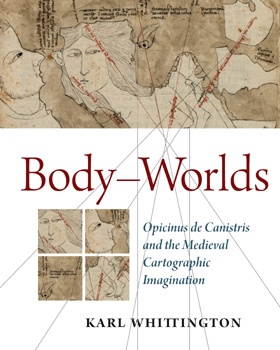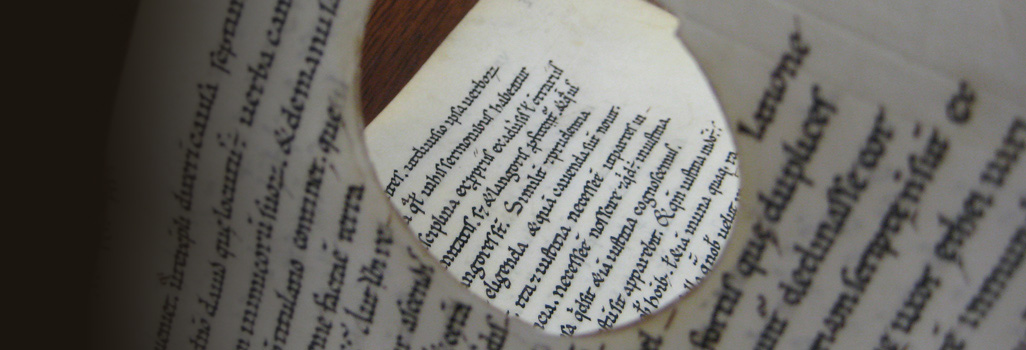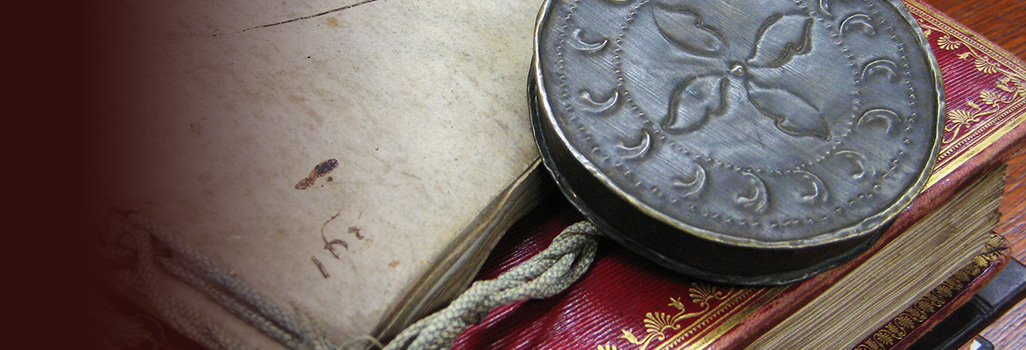
Body-Worlds: Opicinus de Canistris and the Medieval Cartographic Imagination
Studies and Texts 186; Text Image Context: Studies in Medieval Manuscript Illumination 1. 2014. xii, 212 pp.
New in Paperback (2016): ISBN 978-0-88844-426-4 • $45.00
Casebound: ISBN 978-0-88844-186-7 • $85.00
The Italian priest Opicinus de Canistris fell ill in 1334 and had a divine vision that inspired drawings of continents and oceans transformed into human figures; these beautifully strange drawings relate to contemporary maps and seacharts, religious iconography, medical illustration, and cosmological diagrams.
On the last day of March in 1334, an Italian priest named Opicinus de Canistris fell ill. His body slowly became paralyzed, and he temporarily lost his ability to speak. But during this illness, he had a divine vision, and his “interior eyes were opened to discern the images of the earth and the sea.” These “images,” visions of continents and oceans transformed into human figures, resulted in drawings that combined highly accurate maps of the pan-Mediterranean world with striking and often highly sexualized images of human bodies, forms that Karl Whittington calls “body-worlds.”
Creating allegories of natural and spiritual worlds, these drawings defy classification. While they relate closely to contemporary maps and seacharts, religious iconography, medical illustration, and cosmological diagrams, Opicinus's drawings cannot be assimilated to any of these categories. In seeking to visualize the possibilities raised by an entire new way of looking at the world they remain sui generis and a formidable challenge to interpretation. In their beautiful strangeness they complicate many of our most fundamental assumptions about medieval visual culture, even as they help us grasp some of its most basic operations.
Body-Worlds demonstrates the ways that Opicinus's images spark multiple lines of inquiry, for both the medieval viewer and the modern scholar, into the interplay of religion and science, the practice of experimentation, the operations of allegory in the fourteenth century, and ultimately into the status of representation itself. The multiplication of meaning in these drawings is reflected in the book's structure and methodology: it examines Opicinus's imaginary both in relation to medieval forms of knowing and in light of modern theories; at the same time, it remains unwavering in its focus on the visual logic that connects these variegated drawings but also allows them their stubborn individuality and otherness.
View prelims and contents.
Series
Body-Worlds is the inaugural volume of Text Image Context: Studies in Medieval Manuscript Illumination, edited by Jeffrey F. Hamburger, Harvard University.
Author
Karl Whittington is an assistant professor in the Department of History of Art at The Ohio State University. His research and teaching interests include medieval theories of vision and the image, the pictorial mechanics of Trecento painting, medieval medical and scientific imagery, and representations of the body in the Middle Ages. The author of articles on the “psalter map,” on the “cruciform womb,” and on Casper David Friedrich, he has contributed catalogue essays for various exhibitions and to Material Collective, an online forum devoted to visual and material culture. The recipient of a Meiss/Mellon Author's Book Award from the College Art Association and an ICMA–Samuel H. Kress Research Award from the International Center of Medieval Art, he has lectured widely and was a visiting fellow at Kunsthistorisches Institut in Florenz in 2009.
Endorsements
“Karl Whittington's Body-Worlds brings Opicinus de Canistris' idiosyncratic drawings out of the purely personal, mentally disturbed world to which they have generally been consigned into a more normative and accessible realm. To unlock their forms and meanings, Whittington persuasively compares the odd renderings to portolan charts used in marine navigation, which he sees as foundational to Opicinus's project. And, building on the work of Michael Camille and Victoria Morse, he subjects the drawings to a sensitive analysis that never flattens these indisputably eccentric works but, in the end, enhances their innovative nature even while rendering it understandable.” – HERBERT L. KESSLER, Johns Hopkins University
“Opicinus's drawings contribute in new and unexpected ways to our understanding of the late medieval church, the history of vision and sensibilities, the body, the history of cartography, and Mediterranean studies. Karl Whittington is an intelligent reader of these very difficult works and a wonderful guide for readers encountering this material for the first time. His book will open up an important and under-utilized corpus for further study and should spark an on-going conversation about these intriguing manuscripts.” – VICTORIA MORSE, Carleton College
“In Body-Worlds, Karl Whittington has produced a magisterial study of the enigmatic drawings of Opicinus de Canistris. Focusing on a key grouping within the larger corpus of images, he examines some two dozen illustrations that superimpose human bodies on the form of the earth, its seas, and its continents. Two questions guide his task: why would this late medieval thinker adapt a diagrammatic form based on current understanding of cartography; and why turn this image into a system for analyzing broad theological and philosophical questions of the day? Although some scholars believe that Opicinus suffered from a form of physical and mental disorder, and that the drawings reflect a disturbed state of mind, Whittington's complex study indicates otherwise. Whittington does justice to the rich multivalent nature of these drawings, showing us how Opicinus understood the relationship between the body and cosmos, as well as how sexuality and gender worked as important conceptual tools in his visionary system.” – CATHERINE HARDING, University of Victoria
Ordering
Customers in North America please order through University of Toronto Press Distribution by phone (1-800-565-9523) or by email (utpbooks@utpress.utoronto.ca). If you would like to order through UTP Distribution using another method such as mail or fax, please click here for a full list of contact and ordering methods. PIMS books are also available on Amazon.ca (for Canadian customers) and Amazon.com (for customers in the U.S.).
Customers outside North America please order through Brepols Publishers. PIMS books are available through the Brepols online catalogue.


